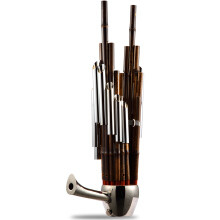The formation of Sheng
The earliest known sheng is Zeng Hou Yisheng, a total of 6 were unearthed, including 12, 14, and 18 tubes. Different regions have different styles of Sheng.

The unearthed sheng reeds are made of bamboo, and the body of the gourd is painted with black background and painted with exquisite patterns. It has been more than 2,400 years old. Before the Han Dynasty, Sheng and Ying occupied an important position in the court, and Ying was relatively more used.
In the past, the Shengdou was made of gourds, the mouthpiece was made of wood, and more than a dozen bamboo pipes of different lengths were in the shape of horseshoes and arranged on the Shengdou. After the Tang Dynasty, performers changed the sheng bucket to wood, and later, after being passed down, the wooden bucket was replaced by a copper bucket, and the reeds were also changed from bamboo to copper.
Due to the long history of Sheng, there are different styles of Sheng in different regions. After the founding of the People's Republic of China, Chinese musical instrument makers and musicians carried out continuous reforms on the sheng, and successively trial-produced a variety of new varieties such as the amplified sheng and the keyed sheng, which overcome the limited range of sound, the inability to transpose and perform fast. Disadvantages such as inconvenience brought new vitality to Sheng.
The timbre of Sheng is bright and sweet, the treble is crisp and transparent, the midrange is soft and full, the bass is deep and deep, and the volume is louder. And among the traditional Chinese wind instruments, it is also the only musical instrument that can blow harmony. When playing with other musical instruments, it can harmonize the sound of the band and enrich the sound of the band. In large national orchestras, sheng sometimes uses three kinds of sheng: treble, alto and bass.
 渝公网安备 50010702504639号
渝公网安备 50010702504639号